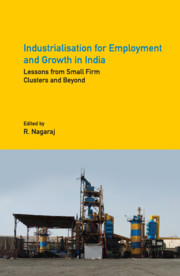Book contents
- Frontmatter
- Contents
- List of Tables
- List of Figures and Maps
- Preface and Acknowledgements
- 1 Introduction
- 2 Garment Cluster in Kolkata: The Untold Story of Expansion Relying on Low-end Domestic Demand
- 3 Constraints to Upgrading and Employment Expansion in the Tiruppur Knitwear Cluster
- 4 Determinants of Employment in the Indian Automobile Industry
- 5 Upgrading Technology and Space as Collective Strategy: Creation of Jobs and Market Potential in Gujarat’s Ceramic Clusters
- 6 Sports Equipment Manufacturing in India: A Firm-level Inquiry into Growth and Employment Dynamism
- 7 Aligarh Lock Cluster: Unravelling the Major Impediments
- 8 Continued Misery or a Change in Fortune? The Case of the Howrah Foundry Industry
- 9 Redevelop and Perish, or Survive and Grow? The Case for Supporting Informal Leather Enterprises in Dharavi, Mumbai
- 10 Growth Performance, Competitiveness and Employment in MSMEs: A Case Study of the Rajkot Engineering Cluster
- 11 Manufacturing and Automation
- About the Contributors
- Index
6 - Sports Equipment Manufacturing in India: A Firm-level Inquiry into Growth and Employment Dynamism
Published online by Cambridge University Press: 31 July 2021
- Frontmatter
- Contents
- List of Tables
- List of Figures and Maps
- Preface and Acknowledgements
- 1 Introduction
- 2 Garment Cluster in Kolkata: The Untold Story of Expansion Relying on Low-end Domestic Demand
- 3 Constraints to Upgrading and Employment Expansion in the Tiruppur Knitwear Cluster
- 4 Determinants of Employment in the Indian Automobile Industry
- 5 Upgrading Technology and Space as Collective Strategy: Creation of Jobs and Market Potential in Gujarat’s Ceramic Clusters
- 6 Sports Equipment Manufacturing in India: A Firm-level Inquiry into Growth and Employment Dynamism
- 7 Aligarh Lock Cluster: Unravelling the Major Impediments
- 8 Continued Misery or a Change in Fortune? The Case of the Howrah Foundry Industry
- 9 Redevelop and Perish, or Survive and Grow? The Case for Supporting Informal Leather Enterprises in Dharavi, Mumbai
- 10 Growth Performance, Competitiveness and Employment in MSMEs: A Case Study of the Rajkot Engineering Cluster
- 11 Manufacturing and Automation
- About the Contributors
- Index
Summary
Introduction
Globally, the size of sports equipment market, by 2025, is expected to be US$89.22 billion. Though this growth will take place mainly in Europe and North America (USA and Canada), the Asian economies of China, India, Pakistan and Thailand will also be the major gainers (GVR 2018). It is considered that rapid technological advancements and continued innovations to keep pace with dynamic consumer preferences will work towards this end. Moreover, a variety of factors such as rising awareness about general health and fitness, easy purchases through e-commerce and m-commerce channels, building of sports infrastructure, better quality raw materials, growing commercialisation and media coverage of mega global sports events such as the Fédération Internationale de Football Association (FIFA) World Cup, Commonwealth Games, Olympic Games and Indian Premier League (IPL) matches may work as growth stimulants to this industry.
In such a situation, this study examines India's sports equipment manufacturing sector by focusing on the Jalandhar and Meerut clusters where this industry is mainly concentrated. In fact, this industry in India evolved during the pre-independence period when access to raw materials, cheap labour and craftsmanship of local people led to its emergence in Sialkot (now in Pakistan). India's partition in 1947 led to forced migration of Hindu entrepreneurs to Jalandhar where they strived to initiate their own micro enterprises (Chattha 2016). Soon after, the industry spread to Meerut and over time, there took place a major concentration of this industry at these two places. Nonetheless, various local conditions and favourable factors facilitated its evolution at other locations such as Jammu and Kashmir, Gurgaon, Delhi, Agra, Moradabad, Mumbai, Pune, Bangalore, Chennai, Tirupur, Kolkata, and so on (Nisar 2013: 84).
Two key questions continue to prevail: first, what sort of growth pattern is observed by this industry and what have been the growth and survival challenges and, second, what has been the plight of labour. Addressing these two questions, this study proceeds with examining the post-1990 state of this industry (the second section) which is followed by cluster specificities (the third section), firm-level operational dynamism (the fourth section), exporters’ concerns and approaches (the fifth section), labour-related issues (the sixth section) and policy framework (the final section).
- Type
- Chapter
- Information
- Industrialisation for Employment and Growth in IndiaLessons from Small Firm Clusters and Beyond, pp. 129 - 152Publisher: Cambridge University PressPrint publication year: 2021
- 2
- Cited by



